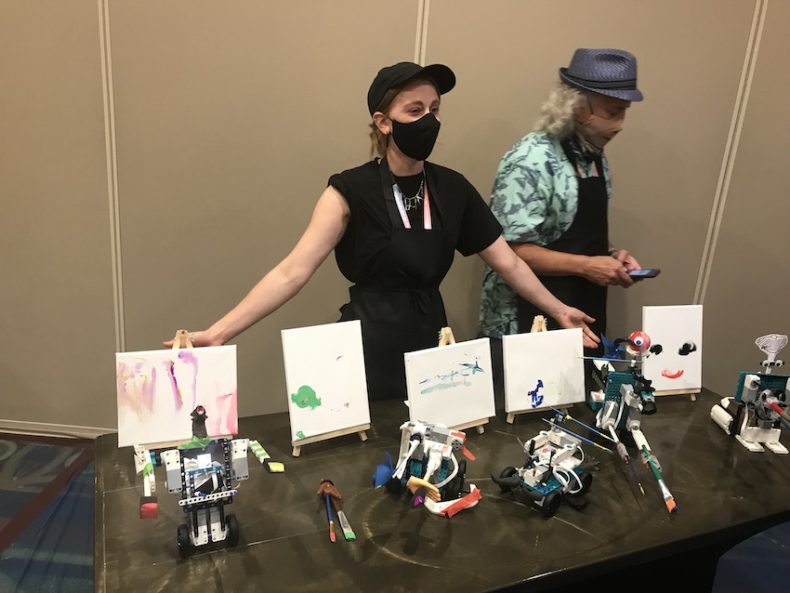
I recently took an ultra-fun workshop run by the Queen of Shitty Robots, Simone Giertz. It’s the second of hers I’ve done, the first being a lightening round of Lego Mindstorm building to create robots that would then be raced against each other over the distance of one meter. This time, we were creating robot artists whose little servomotors would brush a canvas with markers and paintbrushes and highlighters to express their little robot souls.
My team went for iconography and a predictable result, on the right.
When it comes to artificial intelligence and creative tasks, results are not predictable, per se, but they do rely on what you feed the AI. I did some poking around to see whether I could create a blog post ‘in the style of Last Word on Nothing’, because I wondered whether the dozens of writers who have contributed to this site, past and present, had a collective style.
It proved difficult to find the right tool. In a written medium, it’s not quite as simple as feeding the AI some Chopin and receiving Chopinesque music. You have to use a bigger data set just to get it to follow the overall rules of the language, along with your chosen style.
So I did the next best thing, and I don’t mind telling you I find the results a little scary. Using an AI that has read the internet, I prompted it to complete a post that begins with our subtitle quotation by Victor Hugo. It’s a saying that exemplifies the intellectual humility with which we should all approach our learning.
Using the divisive twitter hell on which it was trained, the AI saw that humility and sensed weakness. It filibustered for a while about science and then turned dark and judgey and religious. It did not wait long before going in for the kill. It would have doxxed us all, given a little more information.
Here, for your nervous laughter, is a Last Word on Nothing post, in the style of 2021’s Internet:
—
“Science says the first word on everything, and the last word on nothing.”
– Oliver Wendell Holmes, 1853
Our culture is driven by an obsessive belief that our opinions about the world are always correct. We expect people to accept our view of the world no matter how illogical it is. That, in turn, drives our policy and our politics. When we talk about “climate change,” for example, we are talking about a problem that is supposed to have no solution. When we talk about the “threat of terrorism,” we are talking about a problem that does not even exist.
But the “scientific method” says otherwise. If we can observe something, we can describe it, and we can predict it. There are rules for making observations. There are laws of nature. If we can apply those laws to the world, we can predict what will happen.
This is all well and good in theory. We can predict that the sun will rise in the morning and set in the evening. We can predict that the weather will be hot one day and cold the next. We can predict that the sea will rise when we dig holes in the ground. But what if we find a contradiction between theory and fact?
Contrary to all the “evidence�?the so-called facts �?the theory �?that our culture is obsessed with, science says we cannot always assume that the theories are correct. That is, we cannot assume that the laws of nature are the only things that can exist. Science says there are some facts that we cannot account for with laws of nature, and it says the opposite of what we are being told all the time by our culture.
If you believe in the theory of evolution �?that life on earth came from the primordial goo �?you are guilty of an intellectual crime. Not only are you not being honest with yourself, you are not being honest with the rest of us.
It is a sin against humanity.
The theory of evolution is the greatest scientific hoax of all time.
This article is meant as a challenge. If you believe that the theory of evolution can describe the past and predict the future, you cannot have the same moral code as someone who believes that the world was created in six 24-hour days and that Noah’s Ark is real.
We know what evolutionists claim. We know what they cannot account for. But can we figure out what the science says?
The first step is to recognize that science is a method that people use to investigate reality.
A theory is like a blueprint of reality. The theory of evolution is a blueprint for life on earth. It tells us how life started and what happened over time, and it tells us why people like us should have been around for as long as we have been.
But what if the blueprint was incorrect? What if there was some fact that was left out of the theory of evolution? What if we can observe something that contradicts the theory?
Well, that�?s what we�?re going to find out in this series.
The fact that this AI was trained on twitter posts is a strong argument for getting the hell off Twitter as soon as humanly possible.
Yikes.
To be fair, the AI’s post is shit, but it’s still better than half of what I posted on LWON back in the day. Low bar, I know, but it makes you think!
Ah no, Tom, not better, not by a single atom. Not better. I still remember with such joy, your classic “Ixnay on the IPod: In Praise of Crap Technology.” Which is strangely relevant to Jessa’s shitty AI.
Ha ha, yes Ann — a good point! And I still maintain that “crap” is several notches superior to “shitty.” One is surprised to learn that one has standards, after all.